Recent Works
조환展 / CHOHWAN / 趙桓 / sculpture 2011_0610 ▶ 2011_0710 / 월요일 휴관
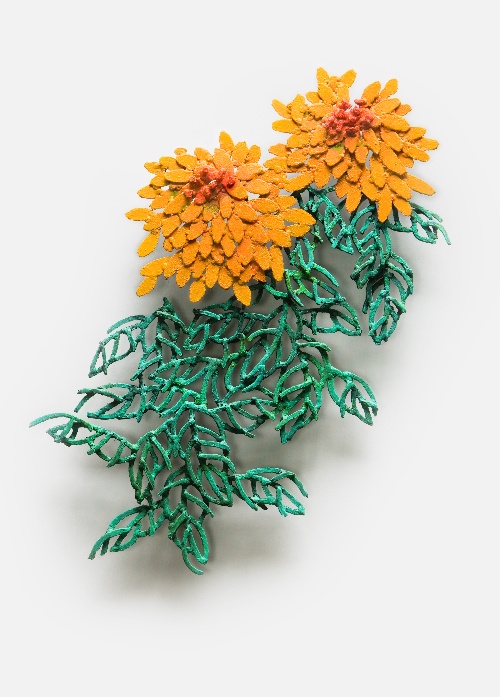
-
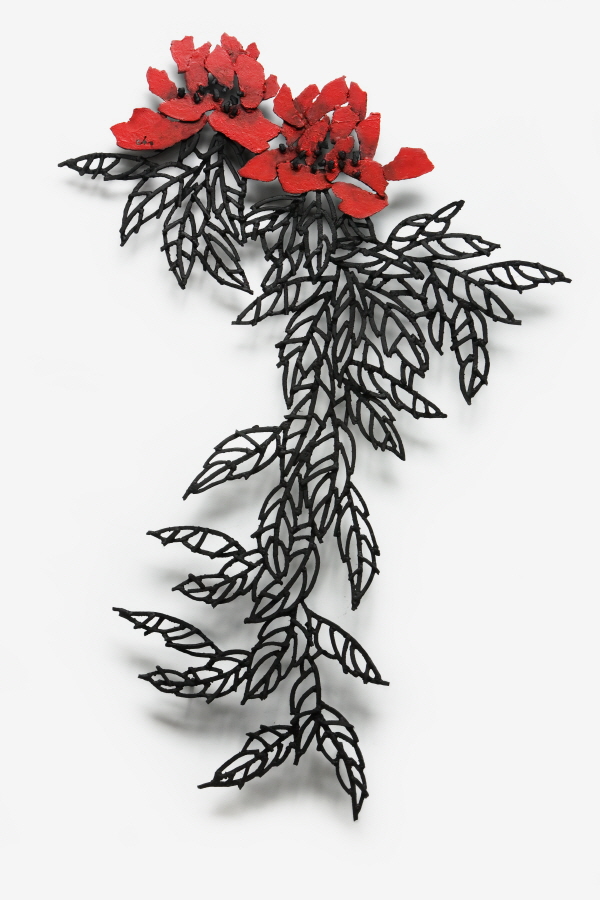
- 조환_Untitled_스틸, 에나멜_89×58×6cm_2011
초대일시 / 2011_0610_금요일_05:00pm
후원,협찬,주최,기획 / 아리랑갤러리
관람시간 / 10:30am~07:00pm / 월요일 휴관
아리랑갤러리 ARIRANG GALLERY 부산시 해운대구 우동 1483 센텀Q 111 Tel. +82.51.731.0373 www.arirangallery.com
그의 작품은 그가 없는 곳에서 기다린다. ● 조환은 자신의 작품을 자신이 가지고 있지 않다. 그는 그 자신의 작품을 소유할 수 없다. 그는 작품을 전시와 관람자와의 관계에서 생성되게 할 뿐 자신의 소유로서 오브제를 가지고 있지 않다. 그의 작품이 우리에게 부재의 존재로 일깨워지는 순간, 그의 미학적 지평이 형성된다. 그의 작품 혹은 제작은 실재와 가상 사이에서, 그리기와 만들기 사이에서, 혹은 그린다는 것의 비실재성과 독자적 오브제와 의미로서 실재성 사이에 있다. 그 사이에 우리를 개입시킨다. 혹은 자기 자신이 무엇을 보고 있는지 하는 자문을 던져주는 질문의 형식을 선택하게 한다.
-
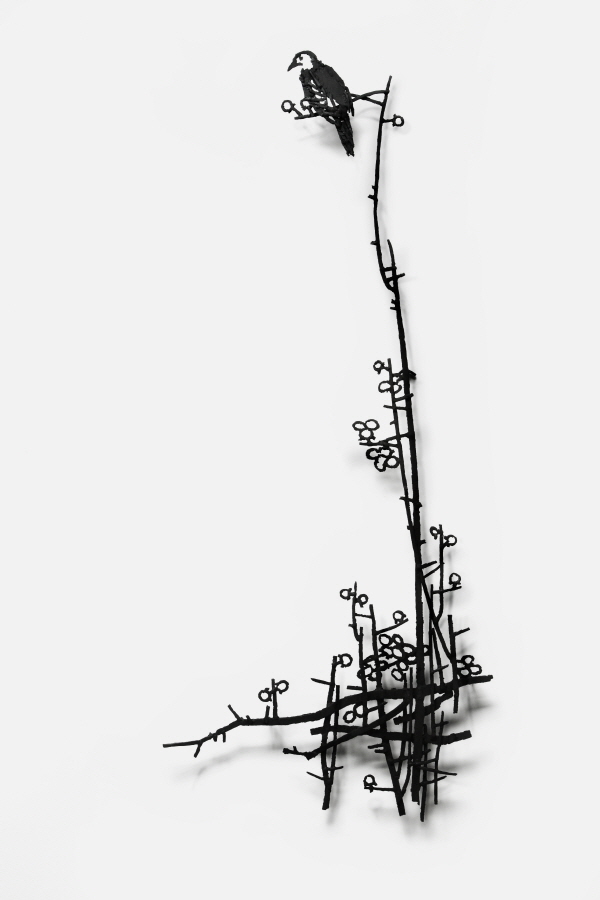
-
조환_Untitled_스틸, 에나멜_123×53×8cm_2011
-
-
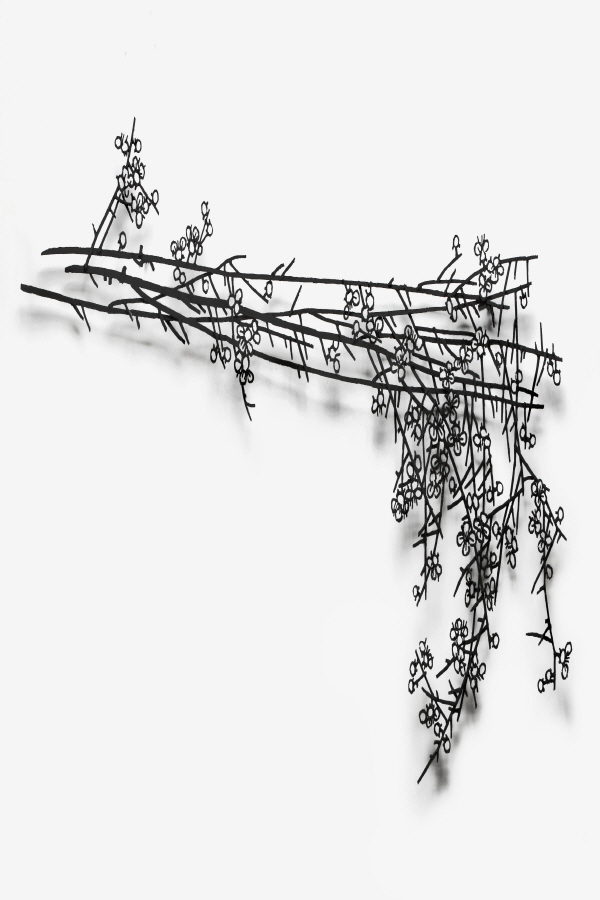
-
조환_Untitled_스틸, 에나멜_99×181×7cm_2011
사군자를 오브제로 재현한, 일견 단순하게 보이는 그의 작품이 던지는 질문은 여러 갈래이다. 그리는 것, 만드는 것, 그려 보이는 것, 만들어 보이는 것에서 출발한다. 그리고 작품 앞에 섰을 때 시각으로 들어오는 오브제와 그림자, 오브제가 보이는 전통적 수묵과 그림자로 드러나는 환영, 그림자의 중첩이 보이는 수묵의 우림효과와 견고한 오브제의 존재감이 서로 충돌하는 장면으로 나아가게 된다. 마치 수묵처럼 결기 있게 쳐놓은 필획을 대신하는 오브제와 더불어 이런 인상들이 얽힌다. 그러면서도 단호할 정도로 수묵의 전통성을 보여주는 어긋남이 그의 작품에서 만나지는 질문이다. 그리고 이런 질문을 덧붙인다. 전통 수묵화의 하나인 사군자를 그려 보인다는 것이 무엇일까. 그것을 오브제로 만나는 것은 어떤 다름일까. 사군자, 혹은 수묵이라는 표현은 이 시대의 우리에게 어떤 의미일까. 그것의 현대적인 번안이나 해석은 가능한 일이긴 할까. 그리고 근본적으로 수묵을 통해 우리가 가 닿으려는 곳은 어디이며 만들기라는 대상의 새로운 해석이 우리에게 던지는 것은 무엇일까. 그리고 정작 우리 앞에 펼쳐지는 공예적 잔망함은 어떻게 해석해야 할까. 그림이나 조각은 없던 것을 만들었다는 면에서 환영이지만 그것만의 독자적 사물이자 의미라는 면에서 실재이기도 한다. 사군자나 수묵화도 환영과 실재라는 맥락에서 이해가 가능한 것일까. 그러나 이런 두 가지의 관점을 벗어버리거나 중첩하면 어떤 모양이 될까. 그의 작품 앞에서의 물음은 우리의 사유를 어디로 이끌 수 있을까.
그의 작품은 사진이나 팸플릿의 인쇄물로 봤을 때와 너무 다르다. 다소 거칠게 말하면 인쇄물은 그의 작품을 담을 수 없다. 그의 작품은 인쇄로 보일 수 있는 그저 단순한 시각적인 효과나 재료 전이를 통한 재치나 과도한 의미부여의 억지스러움에서 일별하게 한다. 직접 보지 않으며 결코 만날 수 없는 부분을 가지고 있다. 그의 작품은 완성된 오브제를 보는 것이 아니라 현장성을 요청한다. 오브제와 더불어 보게 한다. 그런 차이에 대한 작가의 자의식 혹은 자기인식의 여부는 알 수 없지만 그가 강철판을 잘라내고 용접하고 채색하는 과정은 과정에 입안해서 작품을 읽으려는 안이함을 스스로 차단해야 한다. 완성된 작품이라는 오브제가 던져주는 의미, 혹은 미학적 태도가 아니라 바라보는 관람자의 개입이 없으면 작품이 성립될 수 없는 새로운 이해의 문제를 제기한다. 그것은 해석과 이해로서 작품과 소통하는 수용미학적 입장과도 다르다. 작품존립의 문제이다.
-
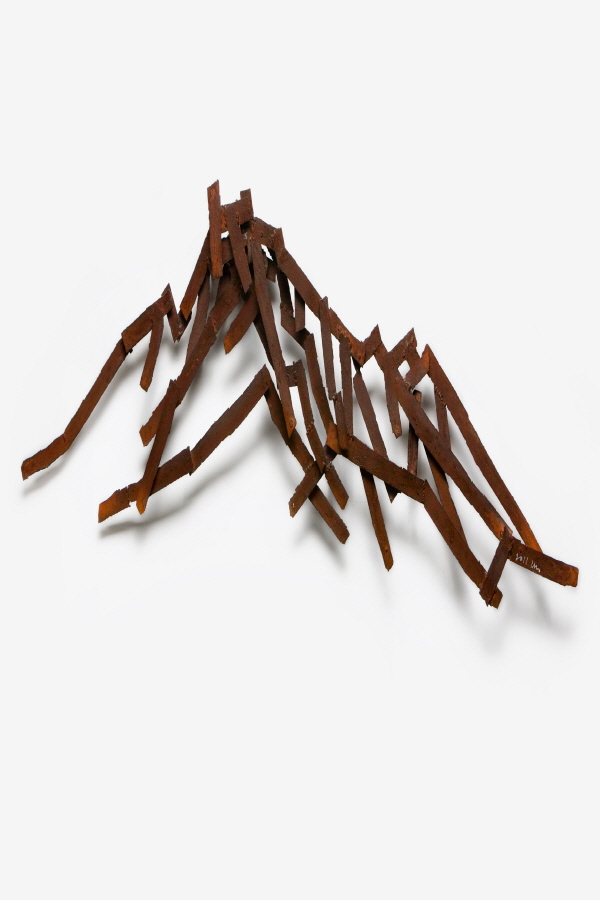
-
조환_Untitled_스틸, 에나멜_39×123×8cm_2011
강철판을 잘라 매화 가지를 만들고 꽃을 만들어 붙였다. 그렇게 솔잎을 만들고 댓잎을 만들고 산의 골기를 찾아간다. 용접을 하니 용접자국이 남고 그것은 태점처럼 가지 사이, 꽃 사이에서 자연스럽게 자리 잡는다. 마치 종이 위에 먹을 치듯 그렇게 강철판을 절단하고 붙여본다. 그러나 용접 자국을 태점으로 삼아 이어지는 선의 흐름과 구성은 단순히 그림을 옮겨놓는 것이 아니다. 때로 녹을 피우기도 하지만 대부분 검은 색으로 착색을 한다. 그런 오브제, 그것은 그저 전통사군자를 오브제로 번안한 정도로 평가할 수 있다. 제작 과정이야 단순한 용접 기술이지만 우리가 보는 것도 그저 하나의 오브제일 뿐이다. 잘하고 못하는 정도로 본다면 장식물을 만드는 장인의 솜씨 정도이고, 공예품의 하나에서 크게 벗어나지 않는다. 사실 이 작품들에서 장식성이 갖는 대중적 이해와 호감, 새로운 시도를 희석 시키는 기술적 위험과 유혹을 부정하기 힘들다. 작가로서 피할 수없는 문제일 것이다. 보는 이가 때로 곤혹스러워지는 부분이도 하다. 그런데 막상 그 오브제가 벽에 설치되는 순간 이런 생각이 조금씩 어긋나기 시작한다. 당연히 조명이 있고, 조명이 이 오브제를 잘 보이게 만든다. 벽과 오브제 사이에 공간이 있기 마련이고 필연적으로 그림자가 생긴다. 그 그림자, 그것은 매화이고 소나무이고 새이고 모란이고 잘 친 대나무이자 서걱거리는 댓잎으로서 한 폭의 수묵화다. 오브제를 걸고 조명이 비치고, 그림자가 벽 위에 생길 때, 비로소 그의 작품이 생성된다. 그리고 조명을 끄고 오브제를 내리면 그의 작품은 없다. 그저 작품이 부재한 오브제가 거기 있을 뿐이다. 그 오브제는 부재된 작품을 드러나게 하는 중간매개일 뿐이다. 오브제와 그림자, 실재와 환영사이라는 질문이 이렇게 던져진다. 그의 작품은 오브제에도 그림자에도 있지 않고, 그 둘 사이에 혹은 그 둘이 만나는 관계에서 비로소 생긴다. 그의 작품은 실재로 있는 오브제가 아니라 관계에 의해 생성되는 순간에 있다. 그가 보여주는 새로운 미학적 제시는 이것이 아닐까.
-
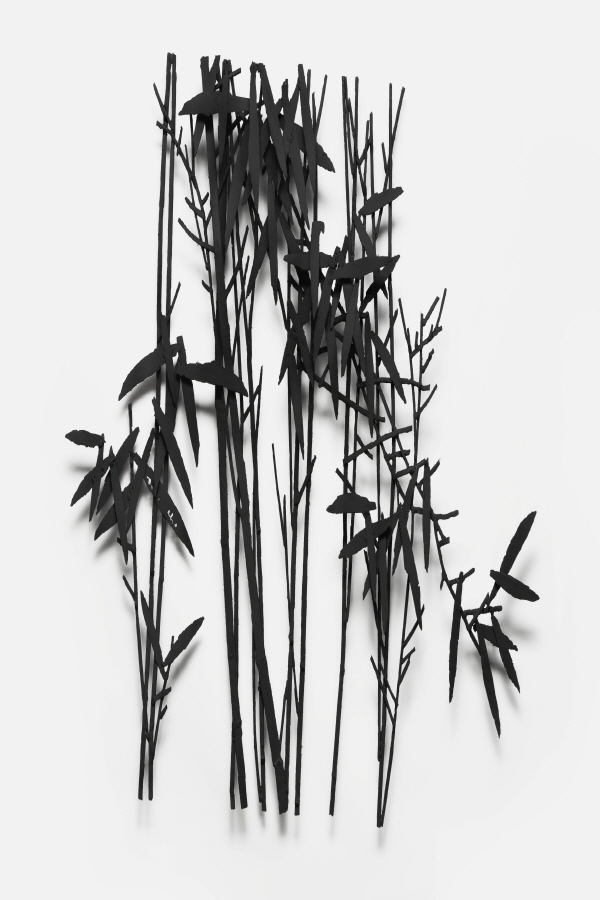
-
조환_Untitled_스틸, 에나멜_71×100×10cm_2011
사실적인 묘사와 실재적 효과를 형성하려는 것은 작가들의 여전한 소망 아닌가. 그러기 위해 얼마나 많은 노력을 들이는가. 그러나 그림이란 언제나 평면의 환영일 뿐, 실재가 아니다. 수묵은 처음부터 그런 실재감으로부터 떨어져 있다. 검은 대, 검은 모란, 검은 매화, 검은 산, 검은 소나무는 어디에도 없다. 그것은 다른 것을 보이려는 것이다. 철저한 사실의 실재감이 아니라 철저한 환영의 무엇을 나타내려 한 것이다. 환영을 만드는 작업이야말로 그가 이즘 하고 있는 오브제 작업이다. 수묵을 강철판으로 바꾸고 붓 대신 오려내고 붙인다. 그리고 그것을 벽에 붙이고 벽에 생기는 그림자를 통해 수묵을 재연한다. 먹으로 그려진 그림을 오브제로 실재화 하려는 것이지만 그것이야말로 또 하나의 환영을 만드는 짓이다. 환영을 가지고 또 다른 환영을 만든다. 사군자를 오브제로 만들고 그 재료의 실재감을 줄이기 위해 검게 채색을 한다. 입체적 실재감이 줄어들 수밖에 없다, 그런데 그 오브제를 벽에 걸고 그림자가 형성되면서 오브제의 실재감이 보다 뚜렷하게 드러난다. 거리, 공간, 환영이 오브제라는 실재에 의해 생성되고 그것들은 서로 중첩된다. 산과 매화, 새와 댓잎이 자신 속에서 거리와 공기를 생성하고 운동감을 얻는다. 조명은 중첩된 선과 음영을 만들고, 단조로운 질감을 풍부하게 시각화 한다. 대는 대숲이 되고 댓잎은 이리저리 흔들린다. 매화는 더 많은 꽃을 달고, 모란은 더 풍성해진다. 조명에 따라 댓잎의 그림자는 농도를 달리 하면서 거칠고 정교함, 움직임과 정지를 보여준다. 소나무 가지에 단단하게 발가락을 걸고 선 새 한 마리는 이런 움직임을 잘 보여준다. 시원하게 뻗은 매화가지, 그 끝에 모여 핀 매화, 그리고 그 뒤쪽으로 어른거리는 그림자로 핀 수묵의 매화송이들, 그림자는 먹색으로 드러나서 이렇게 화면을 새롭게 생성한다. 그림의 재연으로서 강철 절편과 용접은 선긋기와 채색, 일필의 결기 있는 구성을 대신한다. 댓잎과 모란잎 위로 벌레 먹은 것 같은 작가의 서명이 이채롭다. ● 실재와 가상의 중첩 혹은 경계에서 그의 작품은 자신이 있지 않은 다른 곳에서 드러난다. 그는 작품을 전시와 관람자와의 관계에서 생성되게 할 뿐 자신의 소유로서 독립된 오브제를 가지고 있지 않다. 작가가 부재한 곳에 작품이 있고, 작품은 보는 이에게 잠재태로 있을 뿐이다. 그가 그 자신의 작품을 소유할 수 없다는 말은 이런 뜻이다. 실재와 환영, 의미와 시각 사이에서 그림 그리기의 문제를 다시 묻는다. ■ 강선학
-
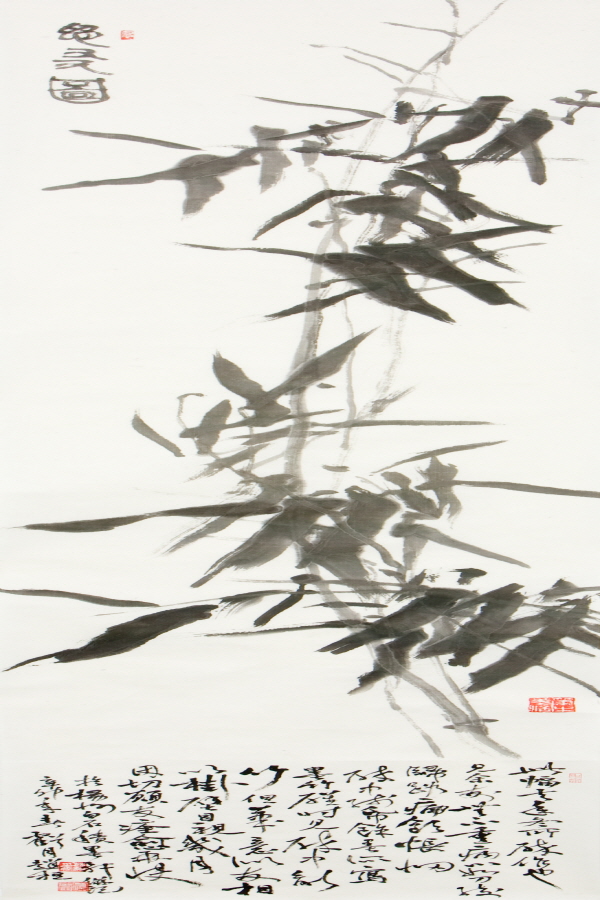
-
조환_思友圖_종이에 먹_165×35cm_2011
His Real Work Is Expecting Where He Is Absent ● Cho Hwan does not have an object of art. He is not able to posses the pieces of art. He does just make an arrangement his work to foster a relationship between the exhibited and the spectators, he does not own the pieces as his possession. As soon as we get the recognition of his absence in his creation, his aesthetic prospect will open up to us. The category of his work and the way of the production has actually been between the real and the imaginary world, the drawing and the making, the unreal of the action of painting and the real of the object as an artwork in itself. He invites spectators to intervene in the situation and let them make a choice among several forms of self-questions about what they are looking at now. ● The questions raised by his work, in which he represents the Four Noble Ones in East Asian art as an object, seemingly quite simple would be mixed. It started out as an action of drawing and sculpture, and an object to be depicted and to be sculptured. When you see it for the first time, it seems to be an art object and its shadow by your visual perception, a traditional oriental ink and wash painting and the illusions created by the shadow, and then it moves to the scene of collision with the rain forest effect by superimposition of the shadow and the solid presence as an object. Seeing the object, these impressions stroke as if it substitutes the spirited brush stroke of Korean ink and wash painting. As doing so, he delivers the very traditional aspects in a very strict way, and therefore the first question which can be captured in his work is the unexpectedness. Moreover, he puts several questions to us. What is Korean traditional ink and wash painting, even a painting of the Four Noble Ones really about for us? What can be distinctive to embody as an object instead of a painting? What does all the expression of Korean ink and wash painting, particularly, the Four Noble Ones in the contemporary art? Is it possible to interpret, to adopt and to modify from a modern point of view? Besides, where is the place it is destined through which the traditional way of art, and what is the new interpretation, making a three dimensional object about for us? How it would be construed when you get actually embarrassed with the feeble attempt employing craftsmanship in decorative art. In terms of creating space and time which is not existed, painting and sculpture can be referred to an illusion, however, it is possible to see it as an entity which is perceived us as a specific thing and has a particular meaning. Is it possible to approach Korean ink and wash painting, even in the Four Gentleman in the context of illusion and reality? What can be done about it, cast it off or pile it up? I wonder where all the questions raised with the work take us to. ● His work of art is quite unlike the image of printed pamphlets. To say roughly, printed ones can not convey the idea of his artwork. When you give it a glance to the printed ones, you might get only a retinal effect, a cleverness by the adventure of the media and too much meaning giving on it. His artwork has the unique aspect which can not be acquired without actual confrontation. The spectators do not see the finished artwork of his, it requires a site-specific observation instead. Invite you to the site to see along with the object of art. I am not quite sure that how much the artist has self-awareness in this proposal, I have to stop the conventional idea of art appreciation in which assuming that how the work of art had been produced, the artist cuts a steel plate, joints it together and paints on it. It raise an issue that the quality of artwork, which was used to be the meaning of the finished work and the aesthetic attitudes of artists, on the contrary, it can not be obtained the qualification as an artwork without the intervention of the spectators. It is different from the perspectives of the Reception theory that emphasizes the spectators' interpretation and understanding of the work of art based on their cultural background. It is the matter of the subsistent quality of artwork. ● He cuts a steel plate to make a branch of plum blossom and paste the flowers on it. In the same way he makes fine tree and bamboo blades, and forms a structure and the spirit of hills. After joint the materials that really marks the melding building a nest between the tree branches, through the flowerers like a protruding naval of baby. He performs a metal work as if he applies a brush work on the paper in ink and water painting. The flow and the composition of lines forming through the marks of melding can not simply be replaced the technique of paintings. Occasionally it covers with rust, mostly it has turned burning color on the surface. It is categorized with the 3D modeling object adopting traditional Four Gentleman into a modern touch: a making process was basic welding skills and the result would be a simple object of art. In terms of dexterity, it seemed the skilled craftsman's work, and it would be fair to say that it falls under the category of decorative art. The facts are hard to deny that the general understanding of decorativeness and public interest and fancy, lethal temptation towards decorative beauty which may lessen the value of new attempts and its achievement; even it is necessary, unavoidable part of life as an artist; the critic, the spectator might feel uncomfortable with it. Even as it is about to install on the wall, things never looking forward to are waiting for us. Of course, there is a lighting, which sheds light on the work; there is a space between the wall and the installed, across which it naturally projects the shadow: it is like a landscape painting made of shadow in company with plum blossoms, fine trees, birds and well depicted bamboo trees, the crunched sound of its leaves as well. At last the artwork is born just as it is installed with lighting on the moment of the shadow is throwing on the wall. There is nothing, off the lighting and the installed, only exist an object, which is the medium to reveal the being absent of the quality of art work. This is the way how the conceptual issue that is about the philosophical question, object of art and its shadow, the real and the illusion is raised. The real essence of his work does not lie in the object of art or in its shadow, but in the relationship with them. In other words, the work of his art would not be the entity as an object but the moment that is creating the relationship. Don't you agree that he might make the aesthetic suggestion to us? ● Realistic depiction and its realization would have been artists' desire, and it still persists, they still put a lot of efforts to do it. Painting is not real but an illusion on the flat surface. The notion of ink and wash painting, however, has been quite away from the real in the beginning. You can not find any black bamboo, black peony, black plum blossom, black mountain, and black fine tree in anywhere. It seeks to convey something else. It is not thoroughly to reproduce the facts but to present something else of illusion. Recently, what he is making an object is to create illusionism : steel plate is used instead of paper, cutting and jointing replace brush work; an object of art installs on a wall and then presents a reflected one with shadow painting. Even though he intended to make an object which used to be a ink and wash painting, the practice, indeed, is to make another illusionism. He creates, therefore, another illusionism with illusion. He paints the object in black to lessen the volume so that actual presence is forced to be thinned. It embodies more obvious presence when the shadow is reflecting after the installation of the object. The elements of painting, composition, distance, space, and illusion is produced by the presence of the object and superimposed with the interaction of them. Hills and plum blossom, birds and bamboo leaves make a distance, form an air, achieve dynamism. The lighting produces overlapped lines and shades and presents rich visualization of tuff texture of the object. Bamboo becomes a forests in which each leaves are swinging from one side to another. Plum blossoms are in full glory and peonies are blooming even more. On lighting technique, the shadow of bamboo leaves presents sophistication, coarseness, the energy of dynamism and placidity arranging darkness and lightness. The bird which is sitting tightly on the twigs of fine tree embodies such dynamism. The newly born painting composes the plain with plum blossom's branch spreading out abroad, of which flowers are blooming on the top, and dark blossoms with the silhouette, which has shadowed like spreading ink in painting. Consequently, steel plate and the applied technique of welding substitutes for line, coloring and empowered composition in painting. It is interesting to see a signature of the artist, which looks like a wormy leaves. ● In terms of the real and illusionism, the essential quality of the work is evident when the artist is absent, sometimes it is superimposed or stand on the border between them. As his work of art is developed only by the relationship between the show and the spectator, he does not posses independent object as his possession, which means that art of work can be presented where the artist is absent as well as for the audiences it can be existed as some potentials. After all he is raising some questions about the ultimate goal of painting in terms of the real and illusionism, the meaning and the retinal. ■ Kang Sunhack
Vol.20110612a | 조환展 / CHOHWAN / 趙桓 / sculpture
